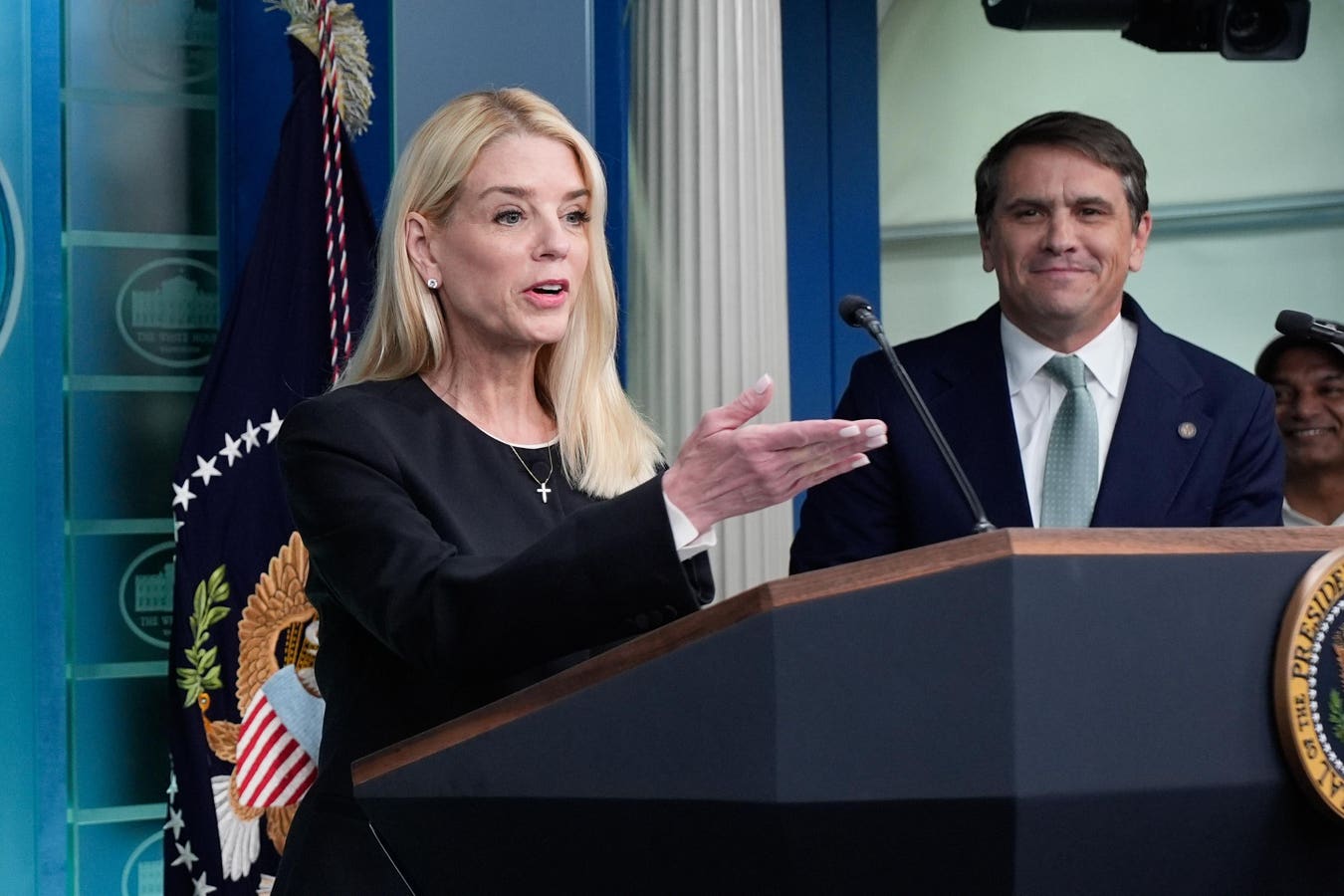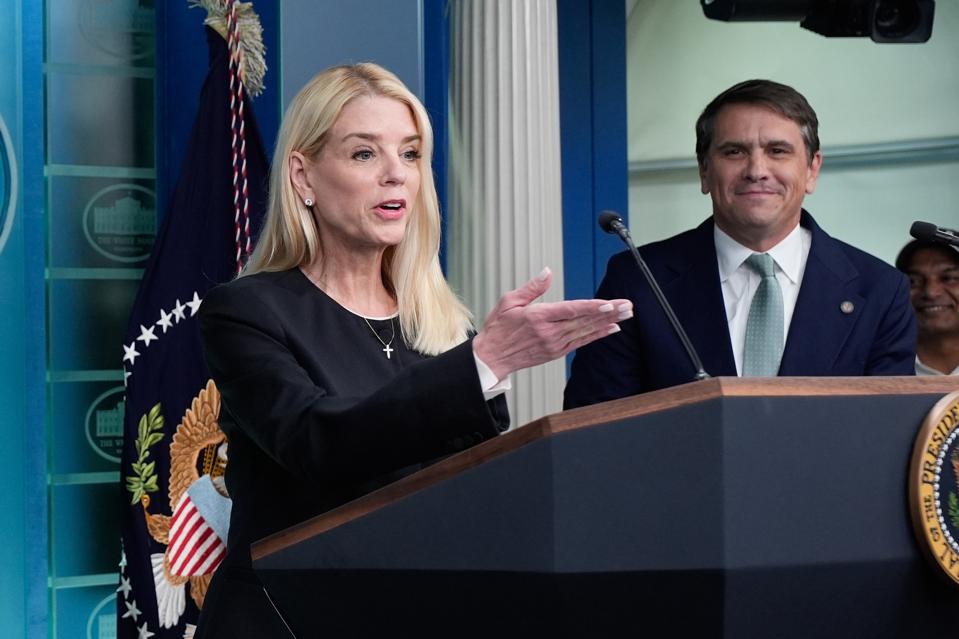Pam Bondi, US attorney general, center, and Todd Blanche, US deputy attorney general, during a news … More conference in the James S. Brady Press Briefing Room of the White House in Washington, DC, US, on Friday, June 27, 2025. President Trump says the US has made a trade deal with “probably four or five different countries,” naming agreements with China and the UK. Photographer: Yuri Gripas/Abaca/Bloomberg
© 2025 Bloomberg Finance LP
The U.S. Department of Justice waded into a case before the Maryland Supreme Court last week, filing an amicus brief urging dismissal of climate lawsuits targeting an array of the nation’s largest oil and gas companies. The DOJ brief was one of eight – including one filed by 24 state attorneys general led by Alabama – filed in the Maryland case, which has yet to be scheduled for oral arguments.
All of the briefs ask the court to uphold lower court dismissals of cases involving Baltimore, Annapolis, and Anne Arundel County which demand compensation for ill-defined damages allegedly arising from global emissions caused by burning of oil and gas. State Judge Steven Platt dismissed the Annapolis and Anne Arundel County case on January 16, 2025, and Baltimore’s case was dismissed by Judge Videtta Brown on July 10, 2024. Following appeals by the plaintiffs, the cases were since combined into a single case before the Maryland high court since they all involve essentially the same arguments.
A Nationwide Campaign of Climate Lawsuits
That latter fact is unsurprising since these cases are part of a nationwide lawfare campaign organized by a handful of law firms – most notably the Sher Edling Firm in San Francisco – in which local governments are convinced to serve as the plaintiffs in hopes of securing lucrative settlements from “Big Oil.” To this point, the campaign, which dates back to at least 2018, has seen little success, with at least 9 similar cases having been poured out of lower courts around the country.
The arguments made by DOJ and others in this week’s briefs reflect similar arguments made by defendants like Chevron, ExxonMobil, Shell, Sunoco, and BP in all of these lawfare cases for the better part of a decade. That is also not surprising, given that the legal principles at stake in these suits have been well established by longstanding court precedent and the prevailing federal environmental statutes.
In every case, the central question judges have had to decide is whether local or state governments can be allowed to essentially regulate air emissions, which have always been regulated at the national level for compelling reasons. The brief filed by the DOJ gets to the nub of this central issue almost immediately.
“Even a cursory reading of Plaintiffs’ complaints shows that these cases aren’t just about local matters, or even Maryland ones. Given that Plaintiffs’ claims take aim at worldwide activities, these consolidated appeals implicate substantial federal interests,” the DOJ states, later adding, “the statute [The Clean Air Act] contemplates no role for states reaching out and applying their law in other states.”
The reality at stake here is that, were state government allowed to promulgate their own air quality regulations, it would become extremely difficult and costly for any company to continue to do business in the U.S. due to having to comply with a patchwork of 50 differing regulatory schemes rather than a single national structure. Complexity and costs would rise exponentially should the courts give thousands of local governments similar powers.
The 24 state attorneys general hit the same point on page 11 of their brief, stating, “Cases involving interstate emissions – i.e., the pollution of air and water within one State from sources in another State – are interstate controversies that implicate the conflicting rights of States. Accordingly, the federal judiciary has understood for well ‘over a century’ the need for federal resolution of such disputes.”
Professor Richard A. Epstein and Professor John Yoo, filing with the Mountain States Legal Foundation (MSLF), take the point even further. “No matter how they try to mask their aims, the plaintiffs/appellants want to misuse the settled laws of nuisance and misrepresentation against the defendants in these cases to set nationwide climate policy, all in violation of federal law and sound tort principles.”
Later in the brief, the professors and MSLF warn, “Every producer, user, and consumer of fossil fuels, and every entity in the supply chain in between, could become the next defendant… This Court should affirm the decisions below… and reject limitless theories of tort liability.”
The Road Ahead For These Climate Lawsuits
Again, every one of the suits filed as part of this organized lawfare campaign have featured the same plaintiff complaints and defendant arguments, involving the same prevailing legal principles. It has all become a burden on the court system that cries out for the U.S. Supreme Court to weigh in with a ruling to inform the lower courts.
Defendants in a case brought by the City and County of Honolulu, Hawaii, asked the nation’s highest court to do just that in an appeal filed last fall. But the justices ruled in January that case is not yet ripe and remanded it back to Hawaii’s Supreme Court for further consideration.
Should the Maryland court rule against them, the oil company defendants in the case would almost certainly file an appeal into the federal courts. It is less clear what the plaintiffs would do in the event of an adverse decision.
The one thing about this costly, tiresome exercise that is crystal clear is that, until the U.S. Supreme Court finally weighs in on these climate lawsuits, they will continue to increase the cost of energy for everyone.

